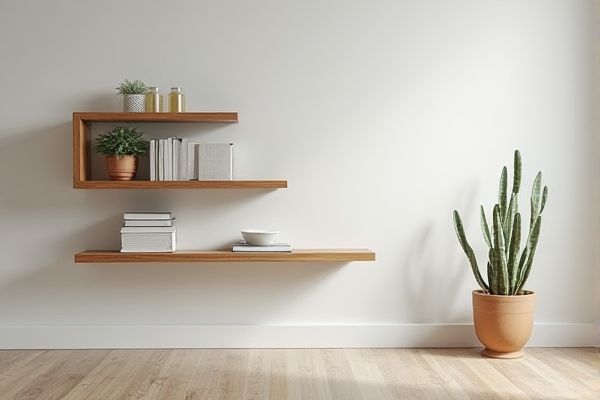
Wall-mounted shelves provide sturdy storage by attaching directly to studs, ideal for heavier items and maximizing vertical space, while floating shelves offer a sleek, minimalist look with concealed brackets that make your decor appear to "float" effortlessly on the wall. Explore the rest of the article to discover which shelf type best suits your home organization and style needs.
Table of Comparison
| Feature | Wall-Mounted Shelves | Floating Shelves |
|---|---|---|
| Installation | Mounted with visible brackets or supports | Mounted with hidden internal brackets for a sleek look |
| Aesthetic | Traditional, noticeable hardware | Modern, minimalist appearance |
| Weight Capacity | Typically higher, supports heavy items | Moderate, best for lightweight to medium loads |
| Maintenance | Easy to clean around brackets | Cleaning can be easier due to lack of hardware |
| Customization | Variety of bracket styles and shelf materials | Limited to shelf thickness and mounting hardware |
| Cost | Generally lower cost options available | Often higher due to design and mounting complexity |
| Common Uses | Bookshelves, storage in garages, kitchens | Decorative displays, minimal storage, living rooms |
Introduction to Wall-Mounted and Floating Shelves
Wall-mounted shelves are secured directly to the wall with visible brackets or supports, providing sturdy storage ideal for heavy items. Floating shelves feature hidden mounting hardware, creating a minimalist, modern look that emphasizes clean lines and space-saving design. Both options offer functional storage but differ significantly in aesthetic appeal and weight capacity.
Design Differences: Wall-Mounted vs. Floating Shelves
Wall-mounted shelves typically feature visible brackets or supports attached directly to the wall, offering a traditional and sturdy design that can support heavier items. Floating shelves, in contrast, create a minimalist and sleek appearance by concealing mounting hardware within the shelf itself, making them ideal for modern interiors where style and clean lines are prioritized. Your choice between these designs depends on the desired aesthetic and the weight capacity needed for your space.
Installation Complexity and Tools Required
Wall-mounted shelves typically require studs for secure installation, involving drills, screws, anchors, and a level to ensure proper alignment. Floating shelves demand precise wall mounting hardware like hidden brackets or cleats, often needing a stud finder, drill, screws, and a level for a seamless, bracket-free appearance. Both require accurate measurements, but floating shelves generally involve more meticulous alignment to achieve their minimalist aesthetic.
Weight Capacity and Stability Comparison
Wall-mounted shelves generally offer higher weight capacity and enhanced stability due to their direct attachment to wall studs, providing robust support ideal for heavy items like books or tools. Floating shelves rely on concealed brackets and anchoring systems, which, while aesthetically pleasing, typically support lighter loads and may require precise installation to maintain stability. Choosing between the two depends on the balance needed between load-bearing demands and design preferences in a given space.
Space Efficiency and Room Aesthetics
Wall-mounted shelves maximize space efficiency by utilizing vertical wall areas, freeing up floor space and creating an organized look ideal for small rooms. Floating shelves enhance room aesthetics with their sleek, minimalist design that appears to "float" without visible brackets, adding a modern and clean visual appeal. Both shelf types contribute to efficient storage solutions but floating shelves excel in offering a contemporary style while wall-mounted shelves provide robust support for heavier items.
Material Options for Each Shelf Type
Wall-mounted shelves typically feature robust materials such as solid wood, metal, or thick engineered wood, offering strong support for heavier items in your space. Floating shelves often use lightweight materials like MDF with veneer finishes or hollow-core wood to achieve a sleek, minimalist look without visible brackets. Choosing between these options depends on your desired balance of durability, aesthetics, and the weight capacity you require for displaying decor or storage.
Cost Analysis: Wall-Mounted vs. Floating Shelves
Wall-mounted shelves typically cost less than floating shelves due to simpler installation and use of visible brackets, reducing material expenses. Floating shelves require hidden support systems that increase both hardware cost and installation time, influencing overall price. Your choice depends on budget constraints and aesthetic preferences, balancing function and design investment.
Maintenance and Durability Considerations
Wall-mounted shelves typically feature visible brackets that provide strong support and easier access for cleaning, making maintenance straightforward and ensuring long-term stability under heavy loads. Floating shelves conceal mounting hardware, offering a sleek appearance but require precise installation to maintain durability and can be more challenging to clean due to minimal surface exposure. Materials used, such as solid wood or metal for both types, significantly impact resistance to wear, moisture, and deformation over time, influencing maintenance frequency and shelf longevity.
Best Uses and Ideal Locations for Each Style
Wall-mounted shelves are best suited for heavy-duty storage in areas like garages, kitchens, or offices where durability and accessibility are key, supporting items such as tools, cookware, or books. Floating shelves, ideal for living rooms, bedrooms, or bathrooms, provide a sleek, minimalist look perfect for displaying decorative objects, photos, or lightweight essentials, enhancing your interior design without visible brackets. Choose the style that aligns with your load requirements and aesthetic goals to maximize functionality and visual appeal in your space.
Which Shelf Type is Right for You?
Wall-mounted shelves provide robust support and are ideal for heavier items, offering a traditional look with visible brackets or supports, making them suitable for practical storage needs in garages or kitchens. Floating shelves, characterized by concealed mounting hardware, create a sleek, modern aesthetic perfect for displaying lightweight decor or books in living rooms or bedrooms. Choose wall-mounted shelves for durability and high capacity or floating shelves for minimalist design and lighter storage options.
 homyna.com
homyna.com